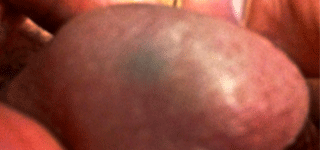A 12-year-old boy presents to the emergency room with a two-day history of testicular pain. The onset of the pain was sudden, and the intensity has remained the same since it began. There are no other associated symptoms.

1. What’s the diagnosis?
2. How is the diagnosis made?
3. What is the treatment?
1. Torsion of the appendix testis
2. The diagnosis is one that can be made clinically. Typical physical examination findings include intact bilateral cremasteric reflexes and a tender nodule on the anterosuperior aspect of the testis with a characteristic blue dot sign. In order to best see the blue dot sign, the skin must be stretched over the upper pole of the testis. However, the blue dot sign is only present in 10 to 23% of patients.1 In cases that are equivocal, Doppler US can be used to rule out testicular torsion.
3. Management of torsion of the appendix testis is supportive with the use of NSAIDs, scrotal support, and rest. Surgical excision of the appendix testis is reserved for persistent, intractable symptoms.2
1. Tekgul S, Riedmiller H, Gerharz E, et al: Guidelines on Paediatric Urology. 2008. http://www.uroweb.org/fileadmin/user_upload/Guidelines/Paediatric%20Urology.pdf. Accessed: January 10, 2014.
2. Palmer JS: Abnormalities of the External Genitalia in Boys. McDougal WS (ed.): Campbell-Walsh Urology. 10th ed. Elsevier Saunders, Philadelphia, PA, 2011, pp. 3592–3593.